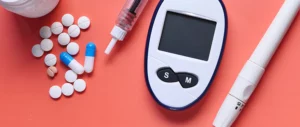Diabetes brings its own set of challenges, and one of the severe complications that individuals with diabetes may face is the risk of strokes. Strokes can have debilitating consequences, making it crucial for those with diabetes to be well-informed about preventive measures and effective treatment strategies. In this blog, we will explore the intricacies of diabetic stroke treatment, shedding light on the latest advancements, lifestyle modifications, and medical interventions that can make a significant difference in managing and preventing strokes in individuals with diabetes.
Contents
Why Does Diabetes Lead To Stroke?
 The connection between diabetes and stroke involves both macrovascular and microvascular complications. Here are some key reasons why diabetes can lead to an elevated risk of strokes:
The connection between diabetes and stroke involves both macrovascular and microvascular complications. Here are some key reasons why diabetes can lead to an elevated risk of strokes:
- Atherosclerosis (Hardening of Arteries)
Diabetes accelerates the development of atherosclerosis, a condition where blood vessels become narrowed and hardened due to the accumulation of plaques. These plaques can rupture, leading to blood clot formation.
- Hypertension (High Blood Pressure)
Individuals with diabetes are more prone to developing hypertension, which is a significant risk factor for strokes. High blood pressure puts additional stress on blood vessel walls, increasing the likelihood of vessel damage and blood clot formation.
- Hyperglycemia (High Blood Sugar)
Prolonged periods of elevated blood sugar levels, a common feature in diabetes can damage blood vessels over time. This damage weakens the vessel walls. And, making them more susceptible to ruptures and the formation of blood clots.
- Dyslipidemia (Abnormal Blood Lipid Levels)
Diabetes often leads to dyslipidemia, characterized by imbalances in cholesterol and triglyceride levels. Elevated levels of low-density lipoprotein (LDL) cholesterol and low levels of high-density lipoprotein (HDL) cholesterol contribute to the formation of atherosclerotic plaques.
- Inflammation and Endothelial Dysfunction
Diabetes is associated with chronic inflammation and endothelial dysfunction, where the inner lining of blood vessels (endothelium) becomes impaired. This dysfunction contributes to a prothrombotic (clot-promoting) state. Ultimately, making it more likely for blood clots to form.
- Diabetic Neuropathy
Diabetic neuropathy, a common complication of diabetes, can affect the nerves that control blood vessel function. Impaired nerve function may contribute to irregularities in blood flow regulation, further increasing the risk of vascular events like strokes.
Individuals with diabetes need to manage their condition effectively through lifestyle modifications, medication adherence, and regular medical check-ups to mitigate the risk of stroke and other cardiovascular complications.
What Are Some Diabetic Stroke Treatment Options?
The treatment of strokes in individuals with diabetes involves a combination of acute interventions to address the immediate impact of the stroke and long-term strategies to prevent future occurrences. Here are some diabetic stroke treatment options:
Emergency Medical Care
In the immediate aftermath of a stroke, emergency medical care is of paramount importance. Prompt recognition of stroke symptoms and quick intervention can minimize the extent of damage. For ischemic strokes, where a blood clot blocks a blood vessel in the brain, thrombolytic medications may be administered to dissolve the clot. Additionally, endovascular procedures, such as mechanical thrombectomy, involve the removal of the clot using catheters.
Medications to Manage Diabetes
 Effective management of diabetes is crucial in reducing the risk of strokes. Medications such as insulin or oral hypoglycemic agents are prescribed to regulate blood sugar levels. Tight glycemic control not only helps in preventing acute complications related to hyperglycemia but also contributes to long-term vascular health. By maintaining stable blood glucose levels, the progression of atherosclerosis and other diabetes-related vascular complications can be slowed down, thus reducing the overall risk of strokes.
Effective management of diabetes is crucial in reducing the risk of strokes. Medications such as insulin or oral hypoglycemic agents are prescribed to regulate blood sugar levels. Tight glycemic control not only helps in preventing acute complications related to hyperglycemia but also contributes to long-term vascular health. By maintaining stable blood glucose levels, the progression of atherosclerosis and other diabetes-related vascular complications can be slowed down, thus reducing the overall risk of strokes.
Antihypertensive Medications
Controlling high blood pressure is a key component of stroke prevention in individuals with diabetes. Antihypertensive medications, such as Angiotensin-Converting Enzyme (ACE) inhibitors or beta-blockers, are commonly prescribed. These medications help lower blood pressure, reducing the strain on blood vessels and minimizing the risk of vessel damage or rupture. Adequate blood pressure management is critical for preventing recurrent strokes and maintaining overall cardiovascular health.
Anticoagulant or Antiplatelet Medications
To reduce the risk of blood clot formation, individuals with diabetes and a history of strokes may be prescribed anticoagulant or antiplatelet medications. Anticoagulants, such as warfarin, interfere with the blood clotting process, while antiplatelet medications, like aspirin, inhibit the aggregation of platelets. The choice of medication depends on factors such as the type of stroke and the individual’s overall health. These medications play a crucial role in preventing the formation of clots that could lead to another stroke.
Lipid-Lowering Medications
Statins and other lipid-lowering medications are prescribed to manage dyslipidemia, a common complication in individuals with diabetes. By lowering levels of low-density lipoprotein (LDL) cholesterol and triglycerides while increasing high-density lipoprotein (HDL) cholesterol, these medications help mitigate the development and progression of atherosclerosis. By addressing lipid abnormalities, these medications contribute to reducing the risk of stroke and other cardiovascular events in individuals with diabetes.
Rehabilitation Services
Following a stroke, rehabilitation services play a crucial role in helping individuals regain lost functions and improve their overall quality of life. Physical therapy focuses on rebuilding strength, coordination, and mobility. Occupational therapy addresses daily activities, helping individuals regain independence. Speech therapy aids those who may experience difficulties with speech and swallowing.
Lifestyle Modifications
Adopting a healthy lifestyle is foundational in preventing recurrent strokes in individuals with diabetes. A balanced diet, rich in fruits, vegetables, whole grains, and lean proteins, can help manage blood sugar levels and reduce the risk of cardiovascular events. Regular physical activity not only supports weight management but also contributes to better blood circulation and overall cardiovascular health. Smoking cessation is crucial, as smoking exacerbates the vascular damage associated with diabetes.
Monitoring and Managing Complications
Individuals with diabetes are prone to complications such as diabetic neuropathy and retinopathy, which can impact stroke risk. Regular monitoring and management of these complications are vital components of diabetic stroke treatment. Diabetic neuropathy, affecting the nerves, may require pain management strategies and lifestyle adjustments. Retinopathy, affecting the eyes, needs careful monitoring to preserve vision.
Education and Support
Education is a powerful tool in empowering individuals with diabetes to actively manage their health and prevent strokes. Healthcare providers offer guidance on medication adherence, blood sugar monitoring, and recognizing signs of complications. Support groups and counseling provide emotional and psychological support, helping individuals cope with the challenges of living with diabetes and recovering from a stroke. Education and support foster a collaborative approach between healthcare professionals and individuals with diabetes, enhancing overall well-being.
Regular Follow-Up Care
Regular follow-up care with healthcare providers is essential for ongoing monitoring and adjustment of the treatment plan. This includes assessing the effectiveness of medications, managing risk factors, and addressing any emerging health concerns. Regular follow-up appointments also provide an opportunity for healthcare providers to reinforce lifestyle modifications, offer guidance, and make necessary adjustments to the treatment plan based on the individual’s evolving health status. Consistent follow-up care contributes to long-term stroke prevention and overall health maintenance.
Individuals with diabetes need to work closely with their healthcare team to develop a comprehensive treatment plan tailored to their specific needs and risk factors. Prevention and early intervention are key components in managing diabetes-related stroke risk.
What Blood Sugar Level Is A Stroke?
 A stroke is not directly caused by a specific blood sugar level. However, uncontrolled or extremely high blood sugar levels, especially over an extended period, can contribute to conditions such as atherosclerosis, hypertension, and inflammation. These conditions, in turn, elevate the risk of strokes. Diabetes, characterized by chronic high blood sugar levels, is a significant risk factor for strokes due to its impact on the vascular system.
A stroke is not directly caused by a specific blood sugar level. However, uncontrolled or extremely high blood sugar levels, especially over an extended period, can contribute to conditions such as atherosclerosis, hypertension, and inflammation. These conditions, in turn, elevate the risk of strokes. Diabetes, characterized by chronic high blood sugar levels, is a significant risk factor for strokes due to its impact on the vascular system.
Over time, poorly managed diabetes can lead to the formation of atherosclerotic plaques, increasing the likelihood of blood vessel blockages or ruptures that can trigger strokes. Individuals with diabetes must maintain target blood sugar levels recommended by their healthcare providers to mitigate the risk of stroke and other cardiovascular complications.
Regular monitoring, adherence to medication regimens, and lifestyle modifications, including a healthy diet and regular exercise, play key roles in managing blood sugar levels and reducing the overall risk of strokes in individuals with diabetes. The specific target blood sugar levels may vary based on individual health factors and treatment plans, making personalized and consistent diabetes management essential in stroke prevention.
Conclusion
In conclusion, diabetic stroke treatment requires a comprehensive approach involving medical care, lifestyle adjustments, and ongoing support. Recognizing the connection between diabetes and stroke risk is the first step, and adopting a healthy lifestyle, including a balanced diet, regular exercise, and not smoking, plays a crucial role. Medications to control diabetes, blood pressure, and cholesterol levels are important components of treatment.
Rehabilitation services aid in recovery post-stroke and regular follow-up care helps fine-tune the treatment plan. Education and support empower individuals to actively participate in their health journey. Do you want to get rid of diabetes? Join our online diabetes treatment program and reverse Diabetes naturally through lifestyle changes such as a Personalized Diet plan, Exercise, Yoga, dieticians, and health coaches.

